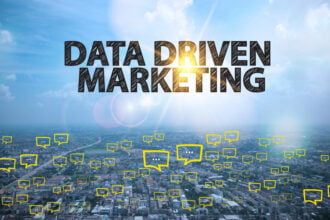Big data has turned the marketing profession on its head. A growing number of marketers are exploring new data-driven solutions to reach new customers and boost their overall ROI.
We mostly talk about the benefits of using big data to improve the targeting of your advertising campaigns. However, there are also a lot of ways that big data can help in regards to the design of ads as well.
Advertisements can be a vital contributor towards a company’s success. You should aim to create an advertisement that is unique, creative and try to make it stand out from the crowd. There isn’t one clear way on how to make an advert a total success. However, there are a few steps every business can take to help them target their customers more effectively.
Big data can be particularly useful for companies that already have a strong technological infrastructure that they can incorporate into their strategy. You need to know how to use big data strategically to get these benefits.
Utilizing Big Data in Your Ad Development Process
You need to track data carefully to create the best ad campaigns. This is going to entail using a tool like Voluum ad tracker for media buyers. You will also need to make sure that the data is used properly after collecting it.
Here are ten data-driven design tips that your company can use to create a compelling ad.
Highlight Your Key Message
If you’re struggling to know where to start when it comes to making an ad, then you should always start by outlining the key message of the brand and have a clear understanding of what you want the campaign to represent. Highlighting your key message can allow you to identify your unique selling points and help give yourself ideas on how to stand out from the rest.
You want your audience to know exactly what your ad represents at first glance. If the message is conveyed clearly then your audience is less likely to be confused.
Big data can make it a lot easier to get your message across. There are a lot of new AI tools that help you see how your message will likely stand out based on data on how similar customers responded in the past. A lot of email automation tools use AI scoring tools to analyze headlines and content to optimize email marketing campaigns.
Tap Into Emotions
The main aim of any ad is to get people to stop and notice it. Tapping into emotions is an effective way to stop someone in their tracks. Adverts that evoke emotion can resonate with an audience and help make your advert more memorable. You can evoke emotion through the use of sentimental imagery, or you can even achieve it just from the choice of colors you use. Red can often be associated with conveying love whilst yellow can help create warmth.
Big data can help you in this regard as well. A lot of machine learning tools are able to evaluate the colors and content in the message and see how they will appeal to people with various emotions.
Use Visual Metaphors
A technique used far and wide in the advertisement world are visual metaphors. Similarly, to a written metaphor, a visual metaphor represents one concept by comparing it to another. Utilizing these can allow you to create something unique that will make your advert stand out. It can be an effective way to engage your audience.
You should be aware to choose a visual metaphor that is obvious enough for the consumer. If it is too complicated, the consumer is likely to disengage with the ad. You can also use data analytics tools to evaluate the metaphors and decipher a customer’s likely response to them.
Create Eye-Catching Banners
Banner making can be a cost-effective way to display products online across a number of websites. Banner ad tools such as Creatopy and others, are widely popular. They help to increase brand recognition and ad targeting. There are a number of useful resources online that can provide you with the tools that you need to create an eye-catching banner ad for your brand. Before jumping into banner making, you’ll want to ensure that you are aware of the file size and other components. It is vital to do your research so you can create a successful banner ad as this can drive a huge number of new customers to your site.
This is one of the biggest benefits of using big data in ad generation. You can use AI design platforms like Canva to improve the quality of your designs considerably.
Vary Your Color Palette
You should always consider your existing visual brand identity when making an advert. You don’t want to create a pastel-colored advert for a corporate accounting firm as this will most likely not fit in with the brand image. Try to experiment with variations of the brands color palette. You want people to be able to relate the advert to the brand so try not to move too far away from what the brand already represents. This can also be confusing for the consumer.
This is yet another way to use big data effectively. You can randomize your color arrays with machine learning and choose colors automatically that are most likely to resonate with customers.
Call To Action
Try to include a call to action in your advert. They are used a lot in design to help invite the audience to take some action. Do you want them to visit a website? Or maybe want consumers to purchase your product “while stocks last”.
You should try to deliver your call to action as thoughtfully and clever as possible. A lot of ads choose to put their call to action in smaller print but if it is a part of your key message then don’t hesitate to make it big and bold.
Big data tools can help with your call to action as well. However, the machine learning tools are still not as advanced with this aspect, since the call to action response differs more across verticals than most other features of your ad. Nevertheless, big data can still help with your CTA.
Keep Copy Concise and To a Minimum
To keep your consumers engaged you want your advert to be visually pleasing. Too much copy on an advert can encourage consumers to lose interest. Your advert should visually catch the audience’s eye and any copy should be short, punchy and to the point. If your advertisement is accompanied by a strong enough visual, then it shouldn’t matter that the copy is short. Think about the message you are conveying. You want your audience to remember it and if it is easier to consume then it is more likely that your ad will stick in their minds.
Create Movement
On a 2D print ad, it can be difficult to convey movement and speed of a product. Experiment with shapes, shading and motion lines to create a dynamic design which helps represent movement. For example, if you are creating an advert for a cleaning product, you could have a still image of a spillage from a bucket. You could then edit a gap in the spillage implying that your cleaning product has swiped through and wiped it up. Try to merge together two existing images to create an individual piece of movement that sparks the imagination.
AI design tools are able to find ways to create movement effortlessly. You can create sophisticated gifs to accomplish this.
Exaggerate Within Reason
If you’re going to imply that your product can do something that it in fact can’t, then be wary as this is a fine line to tread. You want your ad to have an impact and be funny so try to introduce a little hyperbole into your design and avoid misleading your consumers. Check out this article, which shows you some useful examples of hyperbole being used in advertising.
Think About the Style of Your Text
If you are creating an ad that has a big, impactful message then you may consider making your type big and bold to help convey the message to your audience. It has been suggested that bold type attracts the most attention from a consumer as it is loud. Consumers are likely to read the message first and if you then have a humorous or eye-catching image to go with it then this can create a pretty memorable ad.
This is one of the best ways that big data can help. You can easily see which fonts customers are most likely to respond to.
Big Data is Invaluable with Ad Development
Big data can be very helpful in the marketing profession. You should consider using it for developing ads, rather than just for improving the targeting of your marketing campaigns.










